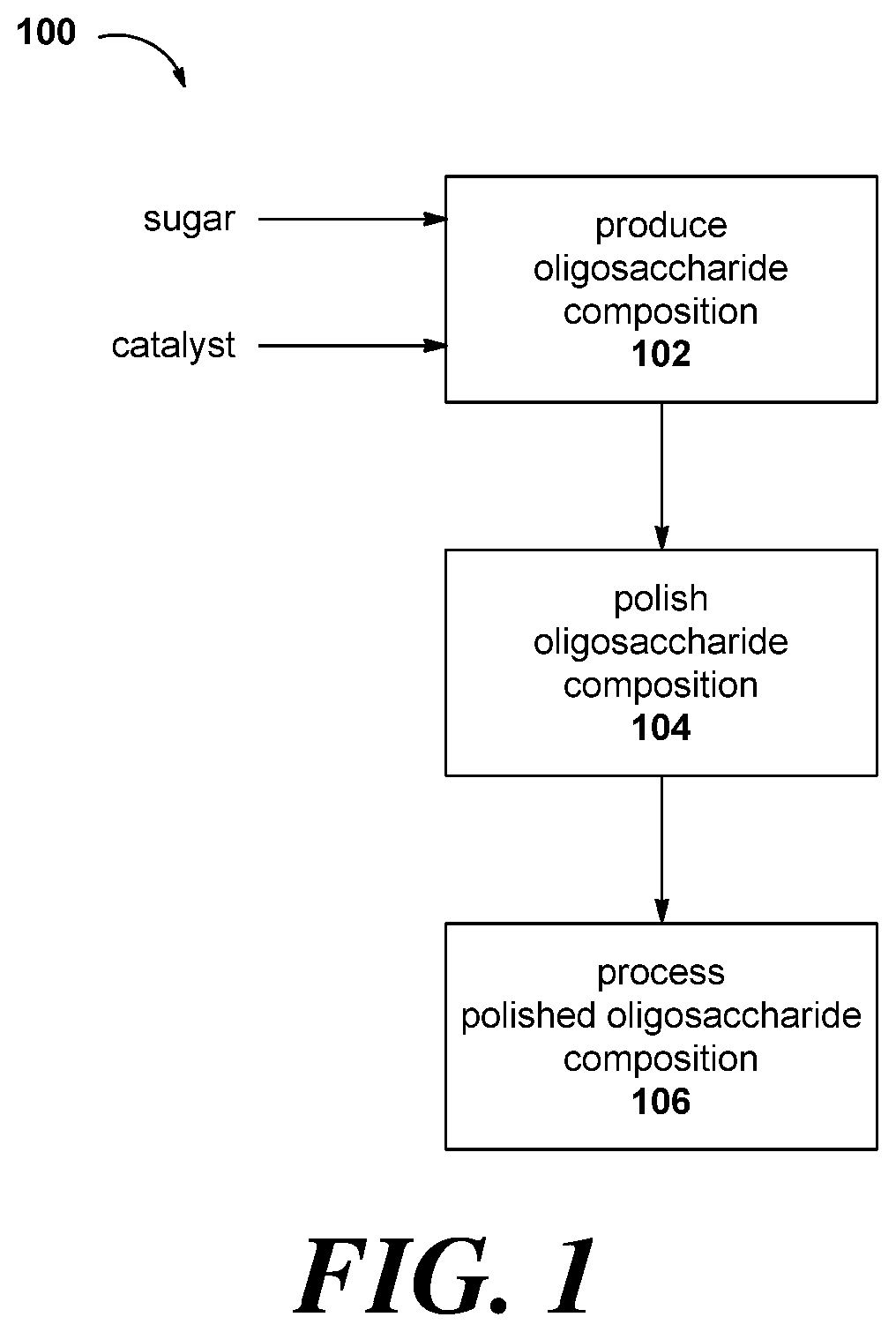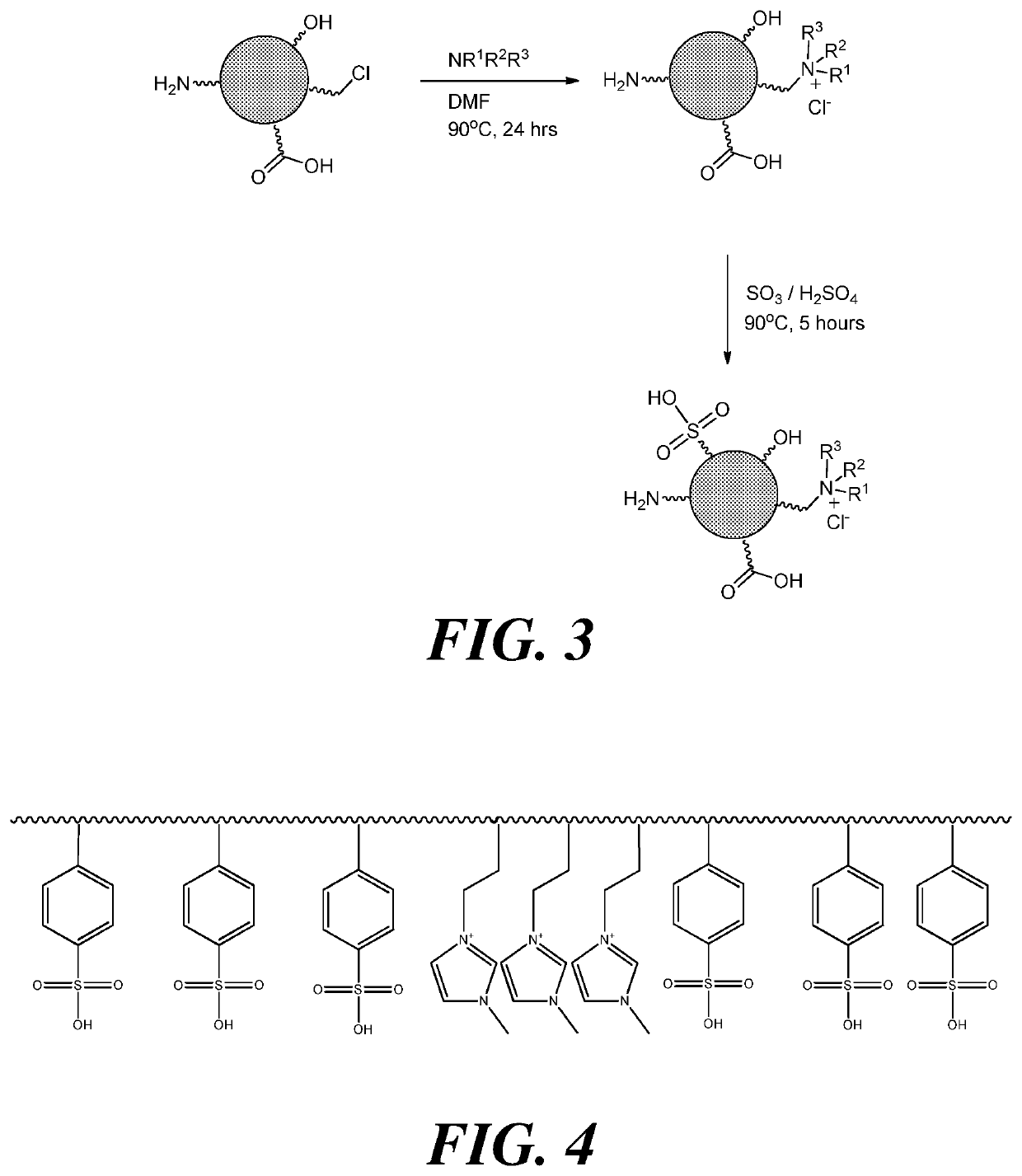Oligosaccharide compositions for use as animal feed and methods of producing thereof
a technology of animal feed and compositions, applied in the field of animal feed, can solve the problems of reducing overall growth performance, affecting the health of animals raised under commercial conditions, and affecting the growth of animals, so as to improve the growth of poultry, reduce the feed conversion ratio of feed, and improve the effect of poultry growth
- Summary
- Abstract
- Description
- Claims
- Application Information
AI Technical Summary
Benefits of technology
Problems solved by technology
Method used
Image
Examples
example 1
Preparation of Catalyst
[2141]This Example demonstrates the preparation and characterization of poly-(styrene sulfonic acid-co-vinylbenzylimidazolium sulfate-co-clivinylbenzene).
[2142]To a 30 L jacketed glass reactor, housed within a walk-in fume hood and equipped with a 2 inch bottom drain port and a multi-element mixer attached to an overhead air-driven stirrer, was charged 14 L of N,N-dimethylformamide (DMF, ACS Reagent Grade, Sigma-Aldrich, St. Louis, Mo., USA) and 2.1 kg of 1H-imidazole (ACS Reagent Grade, Sigma-Aldrich, St. Louis, Mo., USA) at room temperature. The DMF was stirred with continuous mixing at a stirrer speed of approximately 300 RPM to dissolve the imidazole. 7.0 kg of cross-linked poly-(styrene-co-divinylbenzene-co-vinylbenzyl chloride) was then added to the reactor to form a stirred suspension. The reaction mixture was heated to 90 degrees Celsius by pumping heated bath fluid through the reactor jacket, and the resulting heated suspension was maintained for 24 h...
example 2
Preparation of Short Gluco-Oligosaccharides (“GLOS Short”)
[2145]This Example demonstrates the preparation of gluco-oligosaccharides from dextrose using a catalyst with both acidic and ionic groups. The catalyst was prepared according to the procedure set forth in Example 1 above.
[2146]A 22 L jacketed 316L stainless steel reactor (M / DVT-22 mixer / reactor unit, Littleford-Day, Inc., Florence, Ky., USA) was equipped with a mixing element comprising four ploughs with an effective diameter of approximately 95% that of the reactor clear diameter, a bottom-mounted 2 inch diameter outlet port fitted with an 80 mesh stainless steel screen accessed through a manual ball valve assembly, and a top-mounted 3 inch diameter inlet port, also accessed through a manual ball valve assembly. Additional fittings provided the ability to inject compressed gases, steam, and to vent the reactor to relieve pressure. The temperature of the reactor contents was controlled by flowing heated / chilled oil through t...
example 3
Preparation of Long Gluco-Oligosaccharides (“GLOS Long”)
[2149]This Example demonstrates the preparation of gluco-oligosaccharides from dextran using a catalyst with both acidic and ionic groups. The catalyst was prepared according to the procedure set forth in Example 1 above.
[2150]The gluco-oligosaccharides were prepared from dextrose following the procedure of Example 2 as described above, except that the total reaction time was extended to 6 hours. The resulting oligosaccharide concentrate was analyzed by HPLC to determine the product distribution over DP, the extent of formation of sugar degradation products, and the reaction mass balance closure. The product was determined to contain 82.5% kg / kg DP3+oligosaccharides, 6.9% kg / kg DP2 oligosaccharides, 9.5% kg / kg DP1 sugars, and 0.8% kg / kg total levoglucosan, levulinic acid, acetic acid, and 5-hydroxymethylfurfural.
PUM
 Login to View More
Login to View More Abstract
Description
Claims
Application Information
 Login to View More
Login to View More - R&D
- Intellectual Property
- Life Sciences
- Materials
- Tech Scout
- Unparalleled Data Quality
- Higher Quality Content
- 60% Fewer Hallucinations
Browse by: Latest US Patents, China's latest patents, Technical Efficacy Thesaurus, Application Domain, Technology Topic, Popular Technical Reports.
© 2025 PatSnap. All rights reserved.Legal|Privacy policy|Modern Slavery Act Transparency Statement|Sitemap|About US| Contact US: help@patsnap.com



